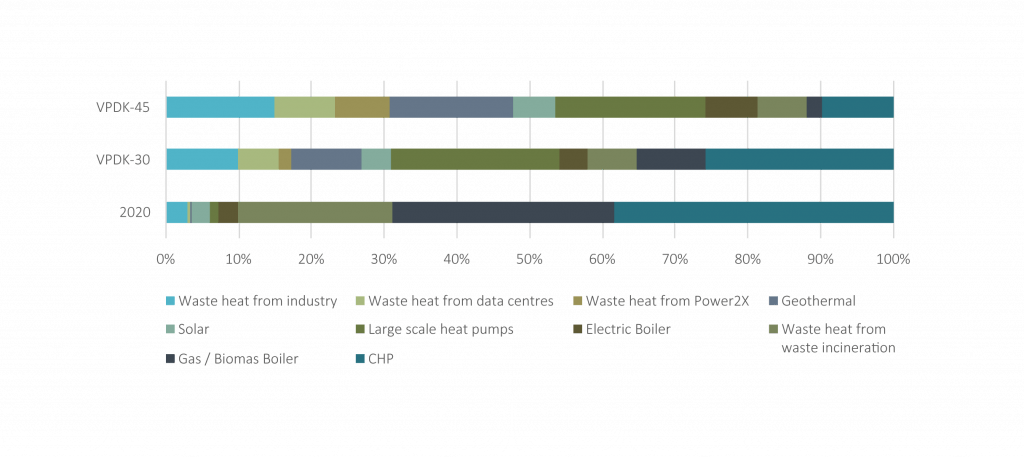To help develop their proposals, the researchers first mapped the geography of both heat supply and demand for the whole of Denmark. The detailed mapping included estimates of annual heat demand; estimates of the heat saving potential for every building from insulation enhancements to optimisation of the heating system through to the installation of intelligent controls. The mapping even included investigating integration potential in the Danish energy system.
Using this mapped data, the team were able to make over 1000 hour-by-hour energy simulations using a national energy system analysis tool to help establish the most effective transitional solutions. Modelling showed that heat savings are an important element in helping keep energy system costs and fuel consumption down because energy savings in the building stock reduce the demand for heat. The researchers found that energy system costs are lowest with heat savings of around 36% in the building stock.
The mapping also included estimates for the cost of around 3000 new district heating systems for areas where they do not currently exist. The researchers totalled the building heat demand data for areas currently without a district heating system to give a heat demand density for each area. Five “expansion scenarios” were simulated using the national energy system analysis tool to model the impact on the energy system hour-by-hour.
Modelling showed the best fit with the energy system would be to expand the district heating from the current level of 50% of the total heat demand to supplying 63-70% of the total heat demand. Buildings currently heated using individual natural gas, oil and biomass heating systems will instead connected to the new district heating systems.
In addition to expanding the total number of district heating systems, the plan also anticipates reducing the temperature of existing district heating systems from the current temperature levels of 80℃ supply/40℃ return to the so-called 4th Generation district heating system temperatures of 55-60℃ flow/25-30℃ return. Reducing the system temperature reduces the heat losses from the piped distribution system while crucially enabling current and future heat sources, such as waste heat, geothermal, heat pumps and solar thermal to be used more efficiently in supplying heat to the district heating system.
The researchers estimate that by 2045, the potential total heat available from waste and geothermal heat is between 12-42TWh/year. This is in addition to the 1TWh/year currently utilised, mainly from electricity production and industry.
In addition, the researchers say that in the future waste heat will be available from Power-to-X facilities (An umbrella term that covers the various processes that turn electricity into heat, hydrogen or synthetic fuels). The heat plan estimates that by 2045, heat from Power-to-X and data centres alongside industrial waste heat and geothermal heat will provide 19TWh/year, almost half the total district heating heat requirement.
Outside the areas covered by district heating, the Heat Plan says the most energy efficient and flexible option is for building heating to be from individual heat pumps supplemented by solar thermal.

The key messages from Heat Plan Denmark 2021
The heating sector can be transformed quickly using available technologies – the four key messages are:
1. Achieving a further 36-40% energy savings in buildings is vital.
This transformation will not be possible by focusing on energy efficiency or by adding renewable energy to the system alone.
2. Heat Networks should be expanded to cover 63-70%.
As gas and oil heating is phased out, and as new urban areas emerge, heat networks should be expanded. Outside heat network zones (rural areas), heating should be provided by individual heat pumps supplemented by solar heating.
3. Heat Networks should be 4th Generation.
The Heat Networks of the future should be 4th Generation with lower temperatures (55-60/25-30). These present the lowest costs and the most efficient use of geothermal, waste heat and large-scale heat pumps.
4. Exploit geothermal and waste heat through good energy planning.
Geothermal and the waste heat from industry, data centres and Power2X should be harnessed, and this requires planning. The Heat Plan for Denmark encourages all municipalities to develop strategic heat plans.
Project coordinator AAU professor Brian Vad Mathiesen, said that implementing the plan will require both planning and the right political framework:
“An important message from us is that all municipalities should prepare a strategic heating plan that looks at district heating expansion and which heat sources should be used in the district heating. And then politicians and authorities must look at the framework conditions so that energy savings and the use of waste heat and geothermal become the obvious ones. We need to follow the smartest path to reach our goal – both economically and environmentally.”
The plan has been developed in collaboration with Danfoss, Grundfos and Innargi, the geothermal company of A.P. Møller Holding.
